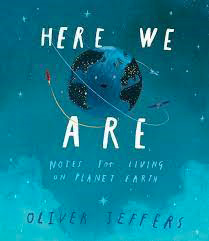Early Childhood Resources Review
Here We Are: Notes for Living on Planet Earth
Here We Are: Notes for Living on Planet Earth
by Oliver Jeffers
November, 2017
Philomel Books
$12.95
Every day children engage with the physical spaces in their environment. We teach them to participate in caring for those physical spaces through picking up toys, putting things back where they belong, and using gentle touches with toys, animals, plants, and other people. Very young children are limited in their thinking beyond their immediate environment. They see the world as my house, my yard, my school. They lack Concept of Place, which geographers define as one’s physical location, relationships among that location and other systems, and one’s feelings about their place in the world (Minkiw 2015)
Epstein (2009) notes that this sense of place is linked to a sense of belonging, a key element in Social Emotional Learning (SEL). Sense of belonging is essential to helping children develop a commitment to caring for their ever-expanding world. How can adults help children to develop growing concepts of place and their responsibilities as a citizen of the world? Effective, engaging, and appropriate children’s literature can be the jumping-off point for conversations about the world, the people and things in our world, our relationship to those people and things, and our responsibility to care for them.
Oliver Jeffers begins Here We Are: Notes for Living on Planet Earth with a salute to new humans, an acknowledgement that our world is a complicated place, and a reassurance that there are people here who can help you to find your way. This book continues Jeffers’s extensive and award-winning work as an illustrator and storyteller who explores big ideas for little people.
Among the big ideas addressed in this book are the concepts of planet, solar system, space, sky, and Earth. Using both scientific and child-friendly vocabulary, Jeffers introduces children to the relationship between land and sea, people and animals, and more specifically, a child’s own relationship to the planet and its inhabitants.
Beautiful illustrations help children to conceptualize big ideas such as the two parts of the Earth—land and sea. For example, the engaging illustrations of the ocean and its inhabitants not only include plants and animals and other ocean features but also show humans above and below this physical space. These illustrations can support conversations about our connection to the ocean and its inhabitants.
The language in this book grows from general to specific. From describing mountains as “pointy” and snow as “frozen falling water” to more specific language addressing constellations as “patterns of stars,” Jeffers offers layers of opportunities for growing vocabulary.
Here We Are: Notes for Living on Planet Earth is a gentle introduction to big ideas such as time and space, relationships, and responsibility. It begins with welcoming a child to the world and ends with the reassurance that we are never alone, and though we will have many questions, there are always others who can help us to answer them.
Over many readings, children and adults can uncover new ideas, spark new questions, and develop a growing understanding of our relationships and responsibilities to the Earth and to one another. As Jeffers concludes, “Well, that is Planet Earth. Make sure you look after it, as it’s all we’ve got.”
Louanne Jacobs (ljacobs@bsc.edu) is an associate professor at Birmingham-Southern College. She has served as a K–12 teacher, director of a professional development center, and now prepares preservice teachers to use children’s literature across curriculum.
Astronomy Earth & Space Science Literacy Early Childhood



